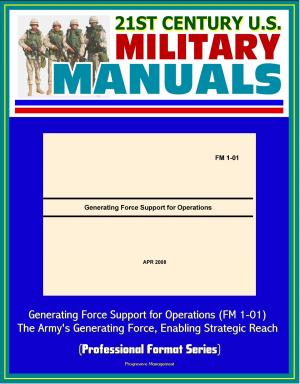Armed Escort for Special Air Operations - An Operational Concept, World War II, Korea, Vietnam, Order of Battle Analysis, Special Operations Forces (SOF), Helicopters, Aircraft, Electronic Combat
Nonfiction, History, Military, Vietnam War, Asian, Aviation| Author: | Progressive Management | ISBN: | 9781310145544 |
| Publisher: | Progressive Management | Publication: | March 22, 2016 |
| Imprint: | Smashwords Edition | Language: | English |
| Author: | Progressive Management |
| ISBN: | 9781310145544 |
| Publisher: | Progressive Management |
| Publication: | March 22, 2016 |
| Imprint: | Smashwords Edition |
| Language: | English |
Professionally converted for accurate flowing-text e-book format reproduction, this unique book study hypothesizes that armed escort is required to protect special operations lift helicopters inserting, extracting, or resupplying SOF ground teams deep in the enemy rear. It compares the escort doctrine and tactics utilized by conventional air assets with current special operations tactics in light of the rapidly increasing threat among lesser developed nations.
This study is based upon a Soviet-style, Third World threat. As the Soviet Union continues to modernize and field new air defense systems and interceptor aircraft, much of the older and some modern equipment is sold or given to allies, clients, and surrogates. The proliferation of highly capable weapons among developing nations has improved their air defenses and significantly complicated the problem of special air operations attempting clandestine penetrations.
Beginning with the historical perspective of armed escort, then examining the current and projected threat, this study concludes that armed escort is indeed required to counter the increasingly capable and proliferating air defense threat. Based upon Phase One of the Concept Based Requirements System, Concept Formulation, this thesis proposes an Operational Concept for armed escort.
The doctrine and tactics for armed escort during deep air assault and deep attack missions already exist in Army and Air Force doctrinal and tactics manuals. Conventional doctrine needs modification, though, to meet the unique requirements of clandestine penetrations 200 or more miles in depth. Part of the adjustment has to be in mindset-forcible entry is the least preferred option in most special operations Direct Action or Special Reconnaissance scenarios.
Many questions and issues raised by this study warrant further attention. Among these are electronic combat implications, appropriate mix of weapons, and training issues. The intent of this thesis, however, was to propose the initial Operational Concept within allowable classification limits and stimulate future quantitative and qualitative studies.
CHAPTER I * INTRODUCTION * CHAPTER II * REVIEW OF THE LITERATURE * Background * Concept Development System * Annotated Bibliography * Historical Perspective * Threat * Current Doctrine * Friendly Capability * CHAPTER III * METHODOLOGY * CHAPTER IV * HISTORICAL PERSPECTIVE * World War II * Korea * Vietnam * Summary/Lessons Learned * CHAPTER V * ORDER OF BATTLE ANALYSIS * What Kind of Fights? * Threat * Technology * Current Doctrine * Friendly Capability * Summary * CHAPTER VI * CONCLUSION & RECOMMENDATIONS * Introduction * Conclusion * An Operational Concept * Other Considerations * Recommendations * Areas for Further Study
Professionally converted for accurate flowing-text e-book format reproduction, this unique book study hypothesizes that armed escort is required to protect special operations lift helicopters inserting, extracting, or resupplying SOF ground teams deep in the enemy rear. It compares the escort doctrine and tactics utilized by conventional air assets with current special operations tactics in light of the rapidly increasing threat among lesser developed nations.
This study is based upon a Soviet-style, Third World threat. As the Soviet Union continues to modernize and field new air defense systems and interceptor aircraft, much of the older and some modern equipment is sold or given to allies, clients, and surrogates. The proliferation of highly capable weapons among developing nations has improved their air defenses and significantly complicated the problem of special air operations attempting clandestine penetrations.
Beginning with the historical perspective of armed escort, then examining the current and projected threat, this study concludes that armed escort is indeed required to counter the increasingly capable and proliferating air defense threat. Based upon Phase One of the Concept Based Requirements System, Concept Formulation, this thesis proposes an Operational Concept for armed escort.
The doctrine and tactics for armed escort during deep air assault and deep attack missions already exist in Army and Air Force doctrinal and tactics manuals. Conventional doctrine needs modification, though, to meet the unique requirements of clandestine penetrations 200 or more miles in depth. Part of the adjustment has to be in mindset-forcible entry is the least preferred option in most special operations Direct Action or Special Reconnaissance scenarios.
Many questions and issues raised by this study warrant further attention. Among these are electronic combat implications, appropriate mix of weapons, and training issues. The intent of this thesis, however, was to propose the initial Operational Concept within allowable classification limits and stimulate future quantitative and qualitative studies.
CHAPTER I * INTRODUCTION * CHAPTER II * REVIEW OF THE LITERATURE * Background * Concept Development System * Annotated Bibliography * Historical Perspective * Threat * Current Doctrine * Friendly Capability * CHAPTER III * METHODOLOGY * CHAPTER IV * HISTORICAL PERSPECTIVE * World War II * Korea * Vietnam * Summary/Lessons Learned * CHAPTER V * ORDER OF BATTLE ANALYSIS * What Kind of Fights? * Threat * Technology * Current Doctrine * Friendly Capability * Summary * CHAPTER VI * CONCLUSION & RECOMMENDATIONS * Introduction * Conclusion * An Operational Concept * Other Considerations * Recommendations * Areas for Further Study















